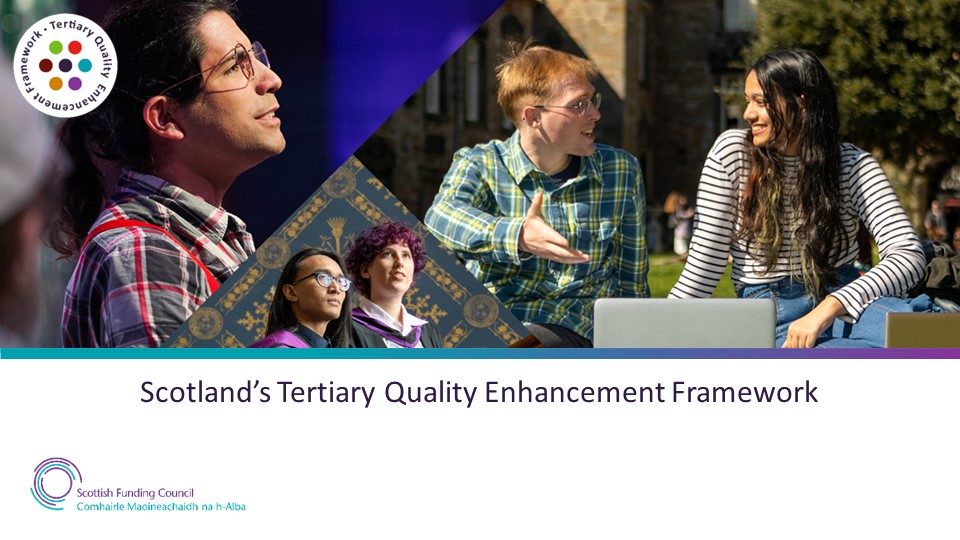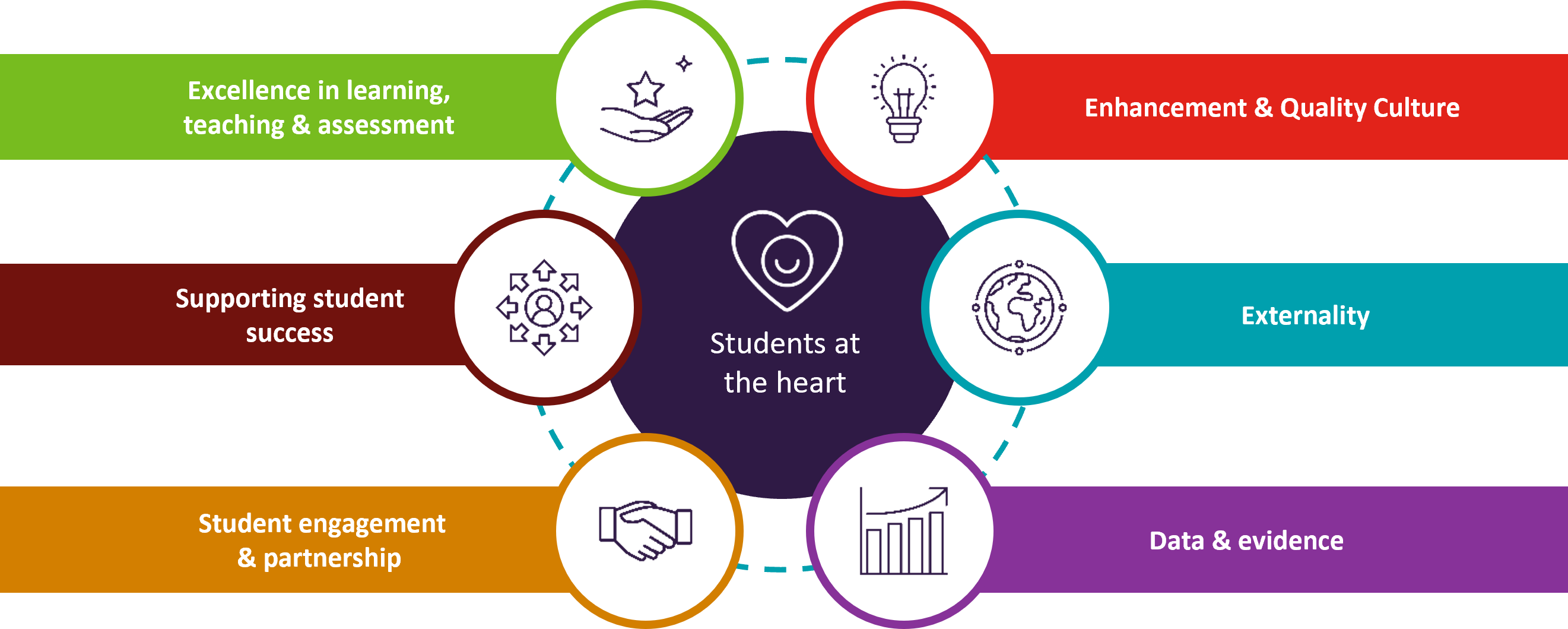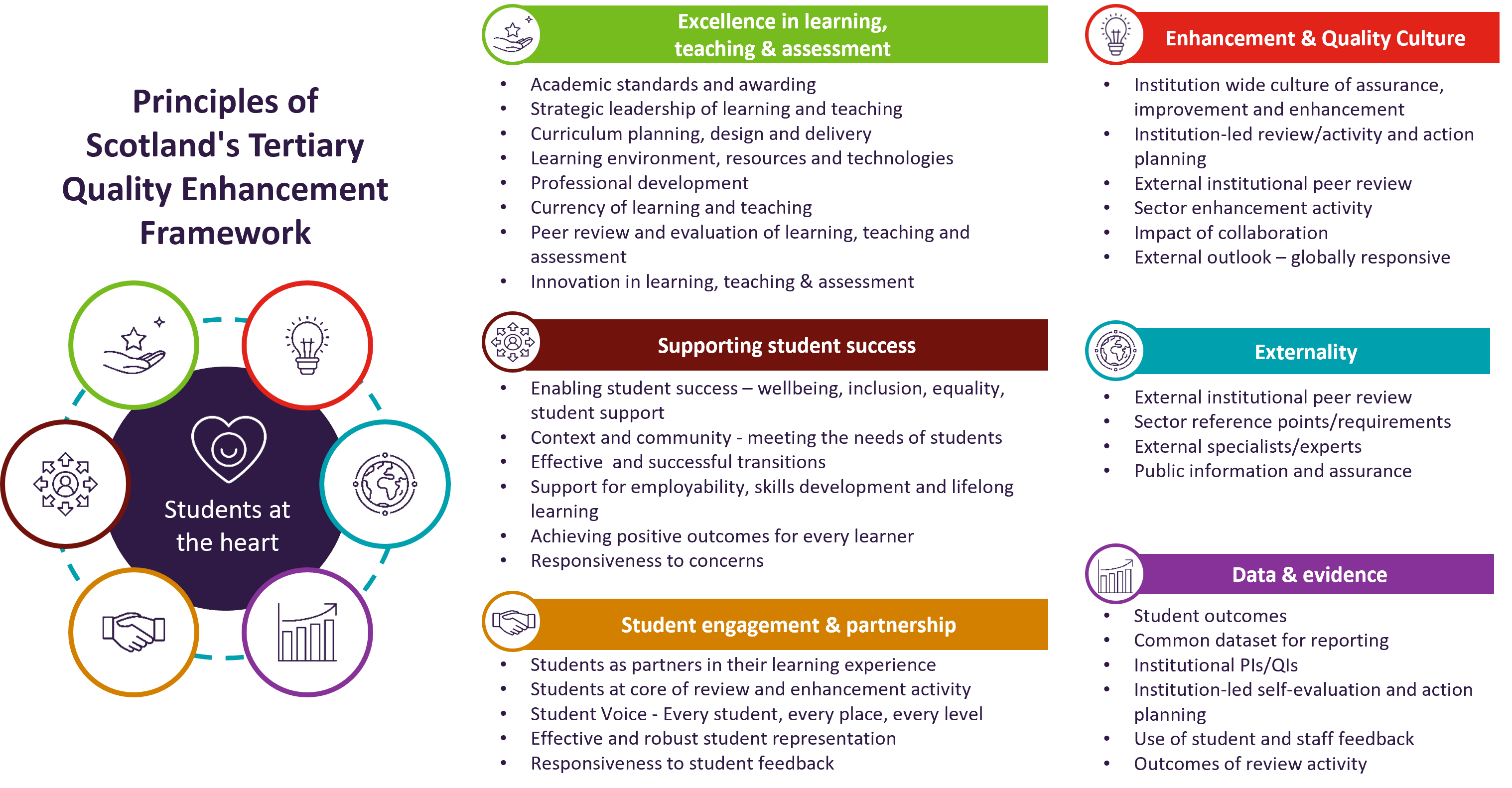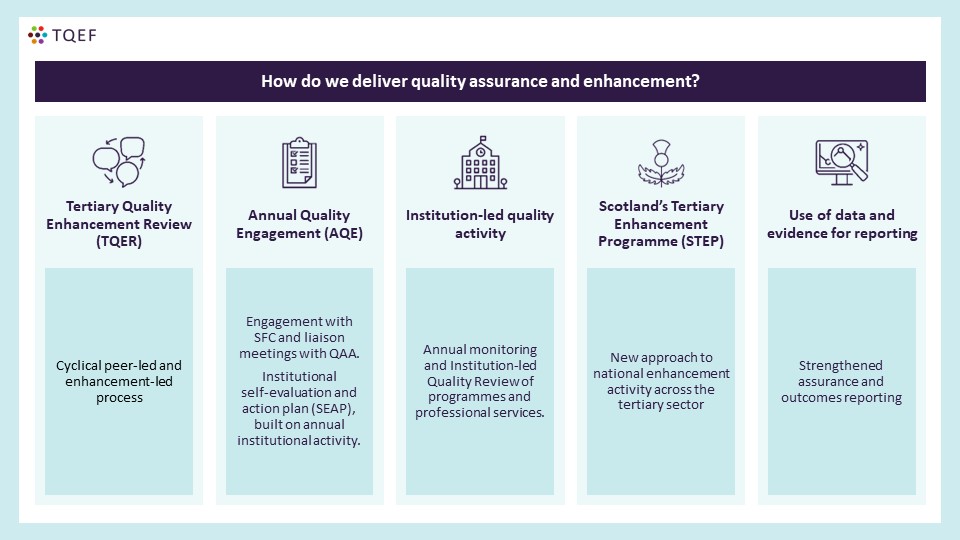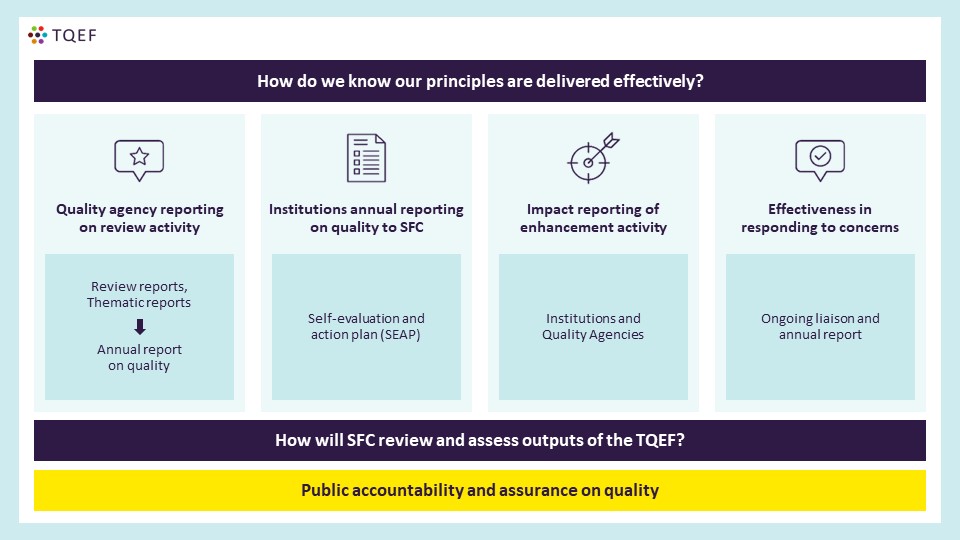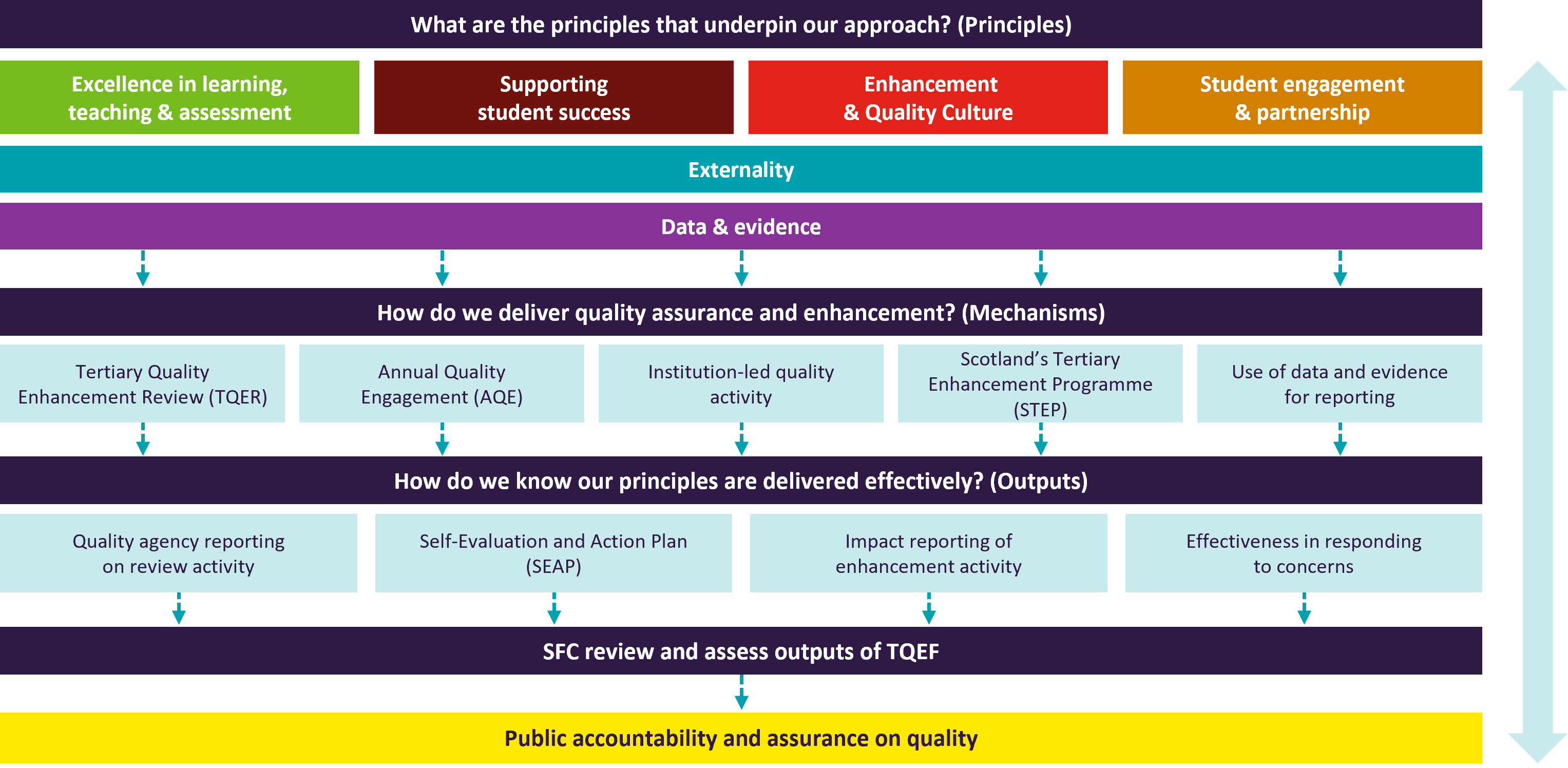
TQEF Toolkit
Register with us
Register with us to view a personalised homepage and to receive emails relating to your interests.
Register hereThe TQEF Toolkit provides resources for sector colleagues who require access to the key TQEF diagrams, speaking notes for internal presentations, the TQEF logo and branding guidelines.
TQEF logo and guidelines
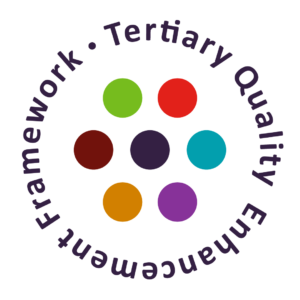
Scotland’s Tertiary Quality Enhancement Framework (TQEF) logo was created to interact with different brandings, backgrounds, colours and images. This allows for a standardised approach while still allowing autonomy to each partner. These guidelines provide guidance on the correct use of the TQEF logo.
Stamp Version
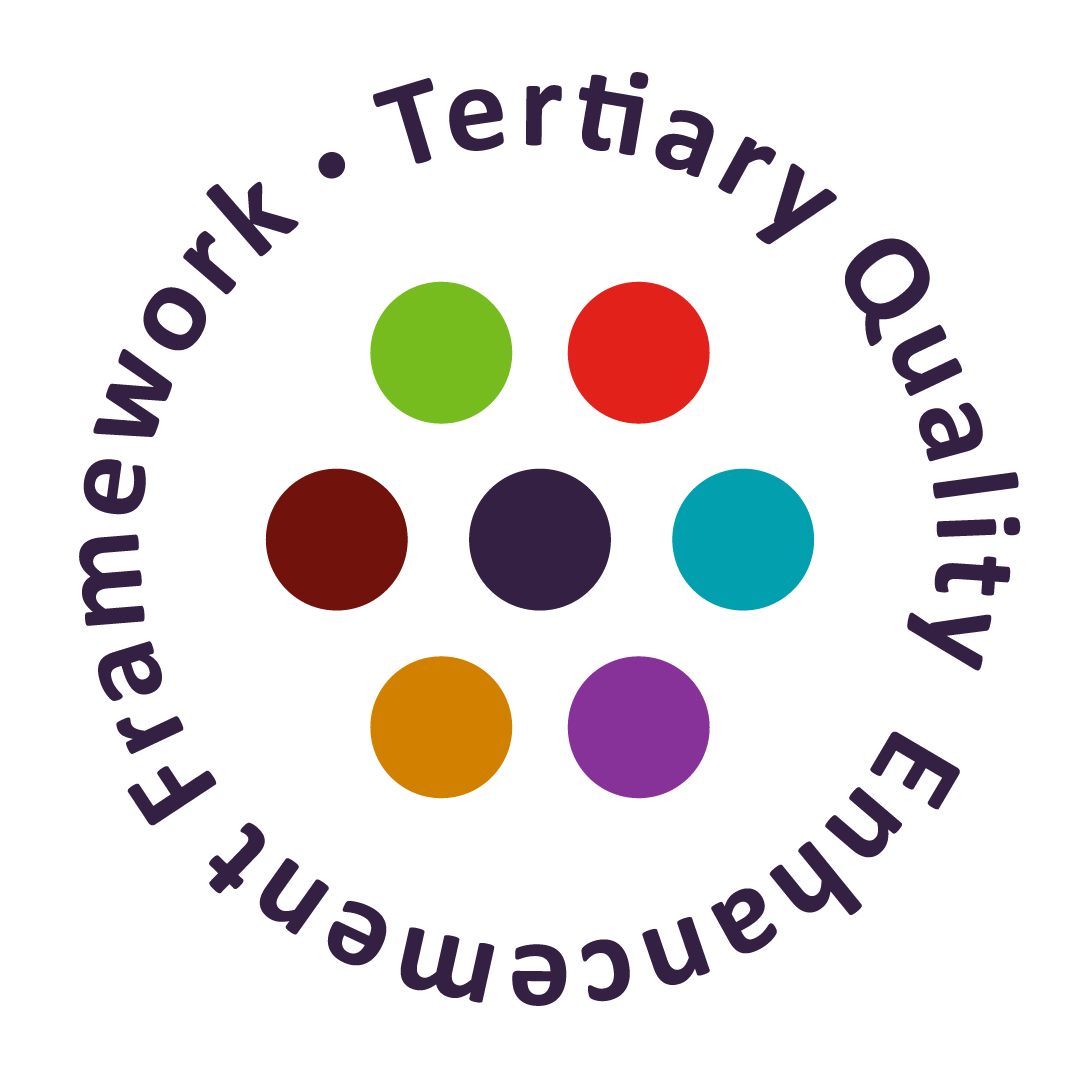
Download logo [PNG]
Exclusion Zone: The exclusion zone is a consistently spaced area around the logo. For the Stamp version of the logo, the exclusion zone is 1X. In which the value of X is the diameter of the darkest circle at the centre of the logo.
Minimum Width: To ensure accessibility and readability, the width should be no smaller than 60px.
Placement: The Stamp version of the TQEF logo was designed to be applied on different backgrounds, colours and images. To maintain a consistent look and feel on different institutions’ branding, we recommend the logo to be applied on the top left corner of the cover of any TQEF publication.
The recommended size of the Stamp version for cover applications is 78x78px. The distance to the top and left margins should be of X in which the value of X is the diameter of the darkest circle at the centre of the logo.
Long Version

Download logo [PNG]
Exclusion Zone: The exclusion zone is a consistently spaced area around the logo. For the Long version of the logo, the exclusion zone is 2X. In which the value of X is the diameter of the darkest circle at the centre of the logo.
Minimum Width: To ensure accessibility and readability, the width should be no smaller than 100px.
Placement: The Long version of the TQEF logo was designed to be applied in combination with other institutions’ logos on light backgrounds.
Acronym Version

Download logo [PNG]
Exclusion Zone: The exclusion zone is a consistently spaced area around the logo. For the Acronym version of the logo, the exclusion zone is 2X. In which the value of X is the diameter of the darkest circle at the centre of the logo.
Minimum Width: To ensure accessibility and readability, the width should be no smaller than 40px.
Placement: The Acronym version of the TQEF logo was designed to be applied on light background and small areas. The logo should only be used when the full name Scottish Tertiary Quality Enhancement Framework appears in a different placement on the page (eg the title of a document).
Alternative formats of our logo are available by contacting us at communications@sfc.ac.uk.
Presentation Diagrams and Scripts
Scotland’s Tertiary Quality Enhancement Framework
Principles of Scotland’s Tertiary Quality Enhancement Framework (Summary)
Principles of Scotland’s Tertiary Quality Enhancement Framework (Detailed)
TQEF Delivery Mechanisms
TQEF Outputs
TQEF - Principles Diagram
Scotland’s Tertiary Quality Enhancement Framework – Script to Accompany Slides
Slide 1: Scotland’s Tertiary Quality Enhancement Framework
Scotland is introducing a new approach to quality assurance and enhancement, Scotland’s Tertiary Quality Enhancement Framework, or ‘TQEF’ will seek to answer the question ‘is the learning provision delivered by Scotland’s colleges and universities of high-quality and is it improving?
Slide 2: Principles of Scotland’s Tertiary Quality Enhancement Framework (Summary)
The TQEF is founded on a set of shared Principles that have been used to shape its development, and will underpin and permeate every aspect of the new Framework, these are:
- Excellence in learning, teaching & assessment
- Supporting student success
- Enhancement and quality culture
- Student engagement and partnership
- Externality and
- Data and evidence.
At the very heart of the shared principles sits our ambition to deliver better outcomes for our students.
The principles were initially developed over AY 2021-22 as SFC started engaging with the sector and stakeholders to explore options for how the common approach to quality assurance and enhancement could be developed and what the key principles underpinning such an approach might be. They were further refined during the co-creation workshops in AY 2022-23.
Slide 3: Principles of Scotland’s Tertiary Quality Enhancement Framework (Detailed)
The Principles are core to the institutional Self Evaluation and Action Plan (SEAP), with institutions expected to reflect on their performance in the first four headline principles (Excellence in Learning, Teaching and Assessment, Supporting student success, Enhancement and quality culture and Student engagement and partnership), while “Externality” and “Data and Evidence” are underpinning and are expected to be threaded throughout the narrative.
The Tertiary Quality Enhancement Review also uses the principles as the basis for evaluation within the new review process.
Slide 4: TQEF Delivery Mechanisms
The TQEF has five interconnected delivery mechanisms that collectively give assurance on the quality of provision delivered by our colleges and universities, and support sector wide enhancement, these include:
- The Tertiary Quality Enhancement Review, or TQER, an external peer-led review cycle of colleges and universities managed by QAA.
- Institutions’ Annual Quality Engagements with QAA and SFC. Briefly, the engagement with QAA will be to discuss preparation for and follow up to external review and with SFC to focus on the institution’s performance, data and evidence that are relevant to quality but also to other outcomes such as funding and widening access as part of the new Outcomes Framework and Assurance Model.
- Institution-led quality activity, this is the normal quality assurance and enhancement activities including annual monitoring and Institution-Led Quality Review (ILQR), that is managed by institutions to evaluate and enhance their provision.
- Scotland’s Tertiary Enhancement Programme, or STEP, a sector owned national enhancement program managed by the QAA and supported by CDN in the college sector.
- Data and evidence will be a thread that runs through all the other aspects of the TQEF; used by students and institutions to reflect on institutional performance, by QAA to inform external review, and by SFC to provide assurance on the quality of provision.
Slide 5: TQEF Outputs
Though the principles and delivery mechanism in themselves will support the tertiary educations sector enhance its delivery of further, higher and work-based learning, it needs to be assessed effectively to evaluate progress and identify areas of good practice, as well as areas for development.
The TQEF will use a range of outputs to assess progress, including:
- Quality agency reporting on review activity.
- The Self-Evaluation and Action Plan, or SEAP. An annual report developed by institutions reflecting on themes arising from internal and external quality processes to inform an institution wide improvement plan.
- Impact reporting on enhancement activity for colleges, universities and our quality agencies.
- And looking at how effectively our institutions respond to concerns and challenges.
Slide 6: Scotland’s Tertiary Quality Enhancement Framework
This is the framework in its entirety, presenting the component parts in a single diagram.
The framework’s principles, delivery mechanisms and outputs can be applied to the different contexts of our colleges and universities to give assurance on academic standards, the quality of the student experience, and ensure accountability for public investment in learning and teaching – supporting SFC’s ambition to make Scotland an outstanding place to learn and educate now and in the future.
Slide 7: For more information
You can find out more about the development and implementation of the TQEF on the dedicated SFC project webpages by using the QR code on screen or going to https://www.sfc.ac.uk/tqef.
For More Information
Descriptive Briefing
Introduction
The briefing below can also be viewed and downloaded as a PDF TQEF Descriptive Briefing
The TQEF is Scotland’s national framework. It assures academic standards and the quality of the student experience, and it ensures accountability for public investment in learning and teaching in our colleges and universities. The TQEF was launched in July 2024 and will operate its first cycle over a seven-year period until 2031.
TQEF Vision and Principles
The TQEF’s vision is for a more coherent and streamlined tertiary education system from the student perspective that delivers the best learning experience for students. The TQEF’s principles are the foundation on which quality assurance and enhancement are based and are designed to put students at the heart of the TQEF in Scotland. They are:
- Excellence in learning, teaching and assessment.
- Supporting student success.
- Enhancement and quality culture.
- Student engagement and partnership.
- Externality.
- Data and evidence.
How is the TQEF delivered
TQEF is made up of five interconnected “delivery mechanisms”, which together provide assurance on the quality of provision and support institutional and sector wide enhancement.
- The Tertiary Quality Enhancement Review (TQER) is the external peer-led and enhancement focused review method for Scotland’s colleges and universities. The programme is managed by the Quality Assurance Agency (QAA).
- Annual Quality Engagement (AQE) is made up of two aspects; Institutional Liaison Meetings with QAA, focusing on TQER preparation and follow up, and SFC’s annual engagements on quality where SFC Outcome Managers discuss high-quality learning & teaching and student outcomes and feed into the SFC’s Outcomes Framework and Assurance Model.
- Institution-led Quality Review (ILQR) reflects institutional responsibility and ownership of quality and the expectation that colleges and universities put in place mechanisms to annually monitor and periodically review their provision.
- Scotland’s Tertiary Enhancement Programme (STEP) is a national programme of coordinated enhancement activity which brings together students and staff from all Scotland’s colleges and universities to deliver innovation, improvement and enhancement. STEP is managed by QAA and College Development Network (CDN), with support from student partnerships in quality Scotland (sparqs).
- Use of data and evidence for reporting, recognises how each run through all aspects of quality assurance and enhancement and feeds directly into evidencing both.
Self-Evaluation and Action Plan (SEAP)
Colleges and universities must submit an annual self-reflection and planning document called the SEAP. The SEAP supports institutions to identify good practice and areas for development, setting out an action plan for enhancement. The SEAP also forms part of an institution’s evidence base for the TQER; supporting review teams to enhance their understanding of institutions strengths, areas for enhancement and enhancement plans.
The review of the SEAP feeds directly into the SFC’s institutional AQE engagement and together with the TQER they are used to assure the quality of learning and teaching provision in Scotland’s colleges and universities.
Roles and Responsibilities
TQEF Delivery Partners
The TQEF delivery partners (QAA, CDN, sparqs and Scottish Credit and Qualification Framework Partnership) have been commissioned by SFC to contribute to and deliver key aspects of the TQEF, and you can find out more in the SFC Guidance on Quality for Colleges and Universities
Students
As students are at the heart of the TQEF, they play a vital role in meeting the TQEF’s vision and its activities. This includes:
- Taking part in TQER activities as external reviewers and meeting review panels to support them gathering evidence and shaping lines of enquiry.
- Taking part in and leading STEP enhancement projects across colleges and universities.
- Completing key surveys and data sources such as the National Student Survey and the College Student Satisfaction and Engagement Survey.
- Representing and communicating the student experience as part of institutional-led quality review activity and in annual engagement with SFC and quality agency meetings.
To support students across colleges and universities, sparqs updated their Student Learning Experience model and developed Scotland’s Ambition for Student Partnership, and are providing direct support to students, Students’ Associations and colleges and universities.
Sector Engagement
Across the development and delivery of the TQEF, sector engagement has been critical. The Tertiary Quality Steering Group (TQSG), has helped shape and guide the co-creation of the TQEF, and will continue to help steer its ongoing development.
Along with TQSG, SFC engages with other key groups such as The Quality Forum, CDN Quality Steering Group, and Universities Scotland Learning and Teaching Committee amongst others.

SFC Strategic Plan 2022-27
Building a connected, agile, sustainable tertiary education and research system for Scotland.
